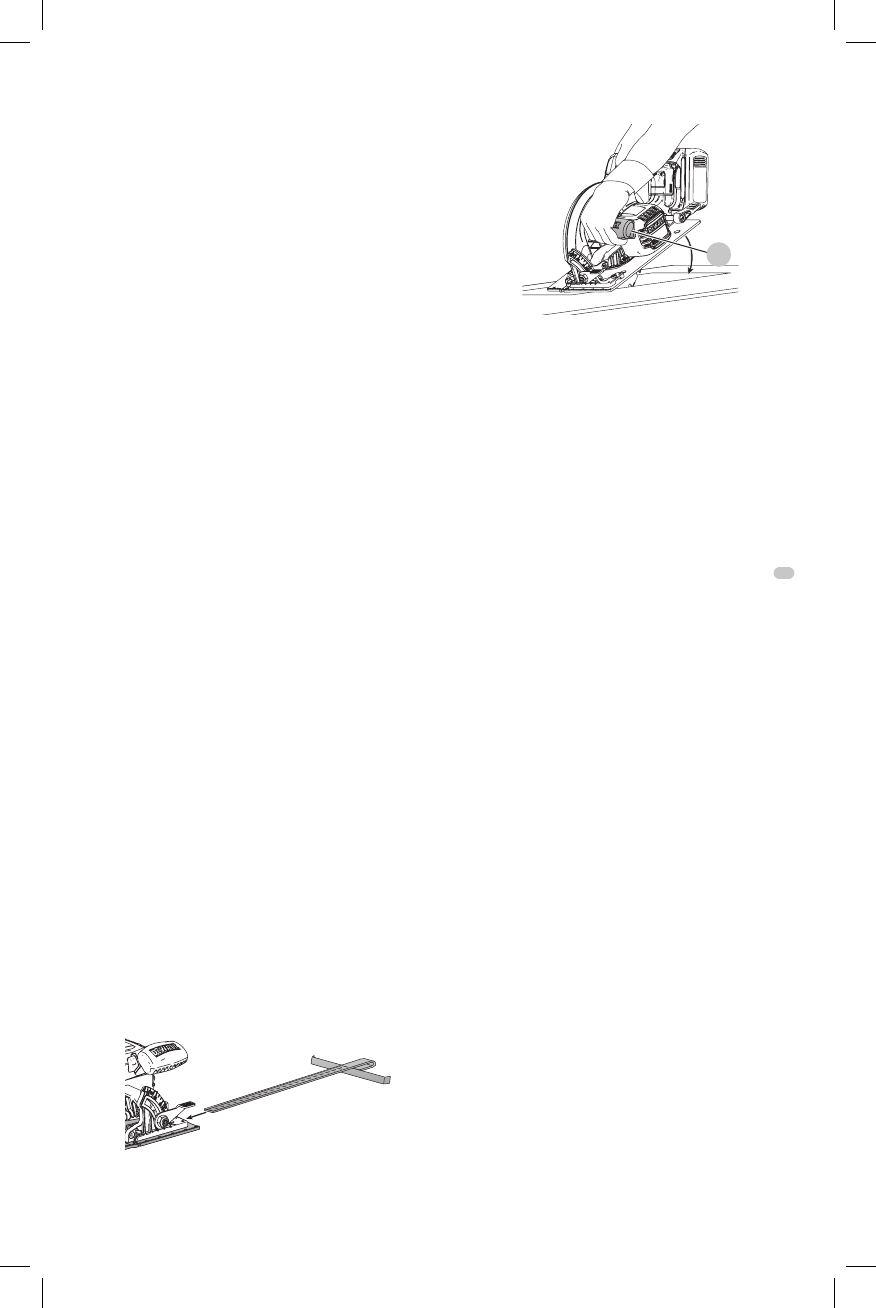Use and Care Manual

ENGLISH
13
Cutting (Fig. M)
Place the wider portion of the saw shoe on that part of the
workpiece which is solidly supported, not on the section
that will fall off when the cut is made. As an example,
FigureM illustrates the RIGHT way to cut off the end of a
board. Always clamp work. Don’t try to hold short pieces by
hand! Remember to support cantilevered and overhanging
material. Use caution when sawing material from below.
Be sure saw is up to full speed before blade contacts
material to be cut. Starting saw with blade against material
to be cut or pushed forward into kerf can result in kickback.
Push the saw forward at a speed which allows the blade to
cut without laboring.
Hardness and toughness can vary even in the same piece of
material, and knotty or damp sections can put a heavy load
on the saw. When this happens, push the saw more slowly,
but hard enough to keep working without much decrease
in speed. Forcing the saw can cause rough cuts, inaccuracy,
kickback, and over-heating of the motor.
Should your cut begin to go off the line, don’t try to force
it back on. Release the trigger switch and allow blade to
come to a complete stop. Then you can withdraw the saw,
sight anew, and start a new cut slightly inside the wrong
one. Withdraw the saw if you must shift the cut. Forcing
a correction inside the cut can stall the saw and lead to
kickback.
IF SAW STALLS, RELEASE THE TRIGGER SWITCH AND BACK
THE SAW UNTIL IT IS LOOSE. BE SURE BLADE IS STRAIGHT
IN THE CUT AND CLEAR OF THE CUTTING EDGE BEFORE
RESTARTING.
As you finish a cut, release the trigger switch and allow the
blade to stop before lifting the saw from the work. As you
lift the saw, the spring-tensioned lower blade guard will
automatically close under the blade. Remember the blade
is exposed until this occurs. Never reach under the work
for any reason. When you have to retract the lower blade
guard manually (as is necessary for starting pocket cuts),
always use the retracting lever.
WARNING: When cutting thin strips, be careful to
ensure that small cutoff pieces don’t hang up on the
inside of the lower blade guard.
Ripping (Fig. P)
Ripping is the process of cutting wider boards into narrower
strips – cutting grain lengthwise. Hand guiding is more
difficult for this type of sawing and the use of a
DeWALT
rip
fence is recommended.
Fig. P
Pocket Cutting (Fig. Q)
WARNING: Never tie the lower blade guard in a raised
position. Never move the saw backwards when pocket
cutting. This may cause the saw to raise up off the
work surface, which could cause injury.
Fig. Q
12
A pocket cut is one that is made in a floor, wall or other flat
surface.
1. Adjust the saw shoe so the blade cuts at desired depth.
2. Tilt the saw forward and rest front of the shoe on
material to be cut.
3. Using the lower blade guard retracting lever, retract the
lower blade guard to an upward position. Lower the
rear of the shoe until the blade teeth almost touch the
cutting line.
4. Release the lower blade guard (its contact with the work
will keep it in position to open freely as you start the
cut). Remove your hand from the lower blade guard
retracting lever and firmly grip the auxiliary handle
12
,
as shown in FigureQ. Position your body and arm to
allow you to resist kickback if it occurs.
5. Make sure blade is not in contact with cutting surface
before starting saw.
6. Start the motor and gradually lower the saw until its
shoe rests flat on the material to be cut. Advance saw
along the cutting line until cut is completed.
7. Release the trigger switch and allow the blade to stop
completely before withdrawing the blade from the
material.
8. When starting each new cut, repeat the above steps.
MAINTENANCE
WARNING: To reduce the risk of serious personal
injury, turn unit off and remove the battery pack
before making any adjustments or removing/
installing attachments or accessories. An
accidental start-up can causeinjury.
Cleaning
WARNING: Blow dirt and dust out of all air vents with
clean, dry air at least once a week. To minimize the risk
of eye injury, always wear ANSI Z87.1 approved eye
protection when performingthis.
WARNING: Never use solvents or other harsh
chemicals for cleaning the non-metallic parts of
the tool. These chemicals may weaken the plastic
materials used in these parts. Use a cloth dampened
only with water and mild soap. Never let any liquid
get inside the tool; never immerse any part of the tool
into aliquid.










